What Vermont students really think about personal learning plans
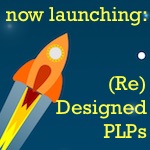 Put 47 middle-level students together, challenge them to think differently about ways to create effective, relevant and meaningful Personalized Learning Plans, and watch the magic happen.
Put 47 middle-level students together, challenge them to think differently about ways to create effective, relevant and meaningful Personalized Learning Plans, and watch the magic happen.
This past summer, we did exactly that.
The back story
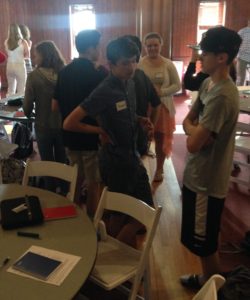
During a faculty meeting at Lamoille Union Middle School, I was inspired by Melissa Piscatelli’s challenge to her colleagues to include students in the personal learning plan (PLP) design process. A large crew from Lamoille engaged in PLP design at the 2015 Middle Grades Institute and launched the results of their well-intentioned and well-planned labors this past school year.
While there certainly were some successes, many agreed student engagement with PLPs fell flat.
Piscatelli invited me into her PLP group to work directly with students to design a more engaging infrastructure.
Since the Lamoille faculty already had experience with the Design Thinking framework to explore the opportunities and challenges of adopting proficiency-based graduation requirements, it made sense to us to invite the students into this work through the Design Thinking process as well.
Wait, why Design Thinking?
We shared this video with the Lamoille PLP groups to help set the context for the work:

We emphasized that once the problem is defined, a key part of effective design is to get feedback from consumers. Designers engage in empathy interviews and work to gain a better understanding of all stakeholders’ needs. Here is Lori Lisai defining our Wicked Problem, which we shared with the students as well.
What we learned from that day got me thinking about how the Tarrant Institute could tap into our network of schools, since all of our partners are currently reflecting on their own PLP implementation and are poised to build from what they have learned.
My hunch was a number of middle schools would be interested in participating in a design thinking challenge where students tackled the puzzle of PLP work. The students would be even more jazzed if they knew they would be working with other middle school students around the state. Finally, since an authentic audience and continued iteration were important to the fidelity of this process, I pitched the following plan:
- a facilitated cross-school Student PLP (Re)Design Thinking Day at a central location.
- a full-day immersion in Design Thinking at the Middle Grades Institute to continue the work focused on PLP development/implementation
- continued participation in this work throughout the 2016-2017 school year and sharing of the prototype iterations with this community through participation in the monthly PLP Pathways Webinars.
The kickoff
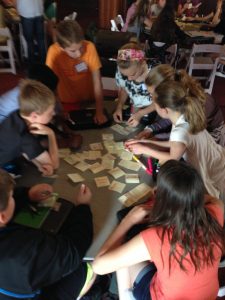
Students from Lamoille Middle School, Hazen Union School, Shelburne Community School, Peoples Academy Middle Level, and Crossett Brook Middle School gathered together at the University of Vermont on May 25th.
They started the day introducing themselves to someone new by sharing one item from their PLP that might help them tell the story of who they are. We prompted them to do so because we were checking our own assumptions that the students attending had built PLPs that included sharing aspirations, goals, and a nod to who they were as learners.
Lori Lisai then led them through the Handshake Challenge.
Table groups wrote on sticky notes words to describe how they best learn and then they grouped the stickies to create 4 key tenets.
The final challenge: create a unique handshake that reflects the 4 tenets. Each school impressed us with its creativity and willingness to share.
The rest of the work day included students pairing up with new peers to conduct empathy interviews about PLP experiences. From this feedback, they rejoined their peers to ideate or brainstorm ‘out of the box’ solutions.
Keeping the momentum going
Upon return to their schools, many of the students reconvened to take stock and plan next steps. For instance, at Crossett Brook Middle School, students revisited their brainstorming sheets and planned action steps:
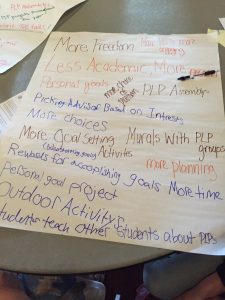
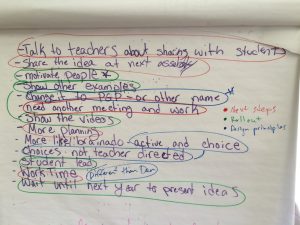
Faculty at Lamoille viewed students’ brainstorming ideas through a Wordle: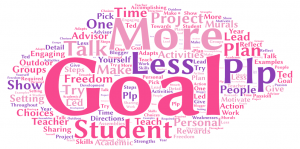
Stage Two: Students as PLP Designers at the Middle Grades Institute
On June 29th the PLP (re)designers gathered once again at Castleton University to continue the work. The crew was made up of students from each of the schools who attended Stage One along with some of their other peers. Alex Bacheller facilitated the day-long immersion into PLP redesign continuing to build on the design thinking framework.
Students revisited the empathy interviews to help frame and focus the work. Their goal for the day was to design a PLP prototype for their respective schools and to create a communication plan to ‘pitch’ their prototype and an implementation plan for the the fall.
[huge_it_slider id=”9″]
Many of these student designers had access to teachers from each of their schools attending the week-long Middle Grades Institute who served as sounding boards for the work. The day culminated with all MGI participants doing a gallery walk of student products. At each table, students were eager and willing to try out their pitches and plans on Vermont educators.
The takeaway:
Students:
There was overwhelming consensus from the students. They needed more voice and choice, in both process and product, and especially platform. Some students redesigned the PLP template using Notability and MineCraft to house evidence of their learning.
Teachers:
“The PLP redesign was a real eye-opener in seeing how students would prefer to create their own projects. It reminded me that, when given the right opportunities, students will jump right into a project and take the responsibility for their own learning and achievement.”
“It reminded me that student voice needs to factor in much more than it currently does in our plan. We need to revisit what are our non-negotiables. Can we let students choose the platform? Their goals? Ways of reflecting? Etc.”
Continuing the conversation
Now that school has started up again, we want to continue the work and share results.
If you want to know more about how you can bring this idea back to your own schools, this dschool k12 blog is filled with example design challenges and resources.
This page might work well to launch your first design challenge with students.


One Reply to “(Re) Designing PLPs with students”
Comments are closed.